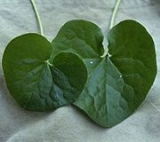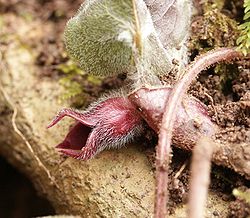
Asarum
Encyclopedia
Asarum is a genus of plants in the birthwort family Aristolochiaceae
, commonly known as Wild ginger.
of low-growing herbs distributed across the temperate zones of the northern hemisphere, with most species in East Asia (China, Japan and Vietnam) and North America, and one species in Europe. Biogeographically, Asarum originated in Asia
They have characteristic kidney-shaped leaves, growing from creeping rhizome
s, and bear small, axillary brown or reddish flowers.
The plant is called wild ginger because the rhizome
tastes and smells similar to ginger root, but the two are not particularly related. The root can be used as a spice
, but is a potent diuretic
. Asarum canadense and other species in the genus contain the nephrotoxic rodent carcinogen
aristolochic acid
, which the FDA warns against consuming.
The birthwort family also contains the genus Aristolochia
, known for carcinogens.
Wild ginger favors moist, shaded sites with humus-rich soil. The deciduous, heart-shaped leaves
are opposite, and borne from the rhizome which lies just under the soil surface. Two leaves emerge each year from the growing tip. The curious jug-shaped flower
s, which give the plant an alternate name, little jug, are borne singly in Spring between the leaf bases.
Wild ginger can easily be grown in a shade garden
, and makes an attractive groundcover
.

Study of the internal transcribed spacer
region (ITS) of nuclear ribosomal DNA
, combined with morphological data, have yielded a better-resolved phylogenetic hypothesis, confirming the distinctiveness of the above-named genera.
However, many botanists still treat these segregated genera as sections of Asarum s.l., especially Hexastylis
Aristolochiaceae
The Aristolochiaceae, or the Birthwort family, are a family of flowering plants with 7 genera and about 400 species belonging to the order Piperales...
, commonly known as Wild ginger.
Description
Asarum is a genusGenus
In biology, a genus is a low-level taxonomic rank used in the biological classification of living and fossil organisms, which is an example of definition by genus and differentia...
of low-growing herbs distributed across the temperate zones of the northern hemisphere, with most species in East Asia (China, Japan and Vietnam) and North America, and one species in Europe. Biogeographically, Asarum originated in Asia
They have characteristic kidney-shaped leaves, growing from creeping rhizome
Rhizome
In botany and dendrology, a rhizome is a characteristically horizontal stem of a plant that is usually found underground, often sending out roots and shoots from its nodes...
s, and bear small, axillary brown or reddish flowers.
The plant is called wild ginger because the rhizome
Rhizome
In botany and dendrology, a rhizome is a characteristically horizontal stem of a plant that is usually found underground, often sending out roots and shoots from its nodes...
tastes and smells similar to ginger root, but the two are not particularly related. The root can be used as a spice
Spice
A spice is a dried seed, fruit, root, bark, or vegetative substance used in nutritionally insignificant quantities as a food additive for flavor, color, or as a preservative that kills harmful bacteria or prevents their growth. It may be used to flavour a dish or to hide other flavours...
, but is a potent diuretic
Diuretic
A diuretic provides a means of forced diuresis which elevates the rate of urination. There are several categories of diuretics. All diuretics increase the excretion of water from bodies, although each class does so in a distinct way.- Medical uses :...
. Asarum canadense and other species in the genus contain the nephrotoxic rodent carcinogen
Carcinogen
A carcinogen is any substance, radionuclide, or radiation that is an agent directly involved in causing cancer. This may be due to the ability to damage the genome or to the disruption of cellular metabolic processes...
aristolochic acid
Aristolochic acid
Aristolochic acids are a family of carcinogenic, mutagenic, and nephrotoxic compounds commonly found in the Aristolochiaceae family of plants, including Aristolochia and Asarum, which are commonly used in Chinese herbal medicine. Aristolochic acid I is the most abundant of the aristolochic acids...
, which the FDA warns against consuming.
The birthwort family also contains the genus Aristolochia
Aristolochia
Aristolochia is a large plant genus with over 500 species. Collectively known as birthworts, pipevines or Dutchman's pipes, they are the namesake of the family . They are widespread and occur in the most diverse climates. Some species, like A. utriformis and A...
, known for carcinogens.
Wild ginger favors moist, shaded sites with humus-rich soil. The deciduous, heart-shaped leaves
Leaf
A leaf is an organ of a vascular plant, as defined in botanical terms, and in particular in plant morphology. Foliage is a mass noun that refers to leaves as a feature of plants....
are opposite, and borne from the rhizome which lies just under the soil surface. Two leaves emerge each year from the growing tip. The curious jug-shaped flower
Flower
A flower, sometimes known as a bloom or blossom, is the reproductive structure found in flowering plants . The biological function of a flower is to effect reproduction, usually by providing a mechanism for the union of sperm with eggs...
s, which give the plant an alternate name, little jug, are borne singly in Spring between the leaf bases.
Wild ginger can easily be grown in a shade garden
Shade garden
Shade gardens are gardens planted and grown in areas with little or no direct sunlight during the day, either under trees or on the shady sides of buildings. Shade gardening presents certain challenges, in part because only certain plants are able to grow in shady conditions. Very few edible plants...
, and makes an attractive groundcover
Groundcover
Groundcover refers to any plant that grows over an area of ground, used to provide protection from erosion and drought, and to improve its aesthetic appearance .- Ecosystem :...
.

Taxonomy
Traditionally the genus Asarum was considered as a single genus with about 85 species. However there has been a trend among botanists to segregate the genus into separate genera, based on considerations of chromosome number and floral morphology :- Asarum s.s. (about 17 species), distributed in Asia (mainly China), North America and Europe
- HeterotropaHeterotropaHeterotropa is a genus of moth in the family Arctiidae.-References:*...
( about 50 species), distributed in Asia - Asiasarum (3 to 4 species), distributed in Asia
- Geotaenium (3 to 4 species), distributed in Asia
- HexastylisHexastylisHexastylis or heartleaf is a segregate of the genus Asarum, in the family Aristolochiaceae. The group comprises ten species endemic to southeastern North America. It is a perennial, evergreen, herbaceous plant with leaves and flowers arising directly from the rhizomes...
( 10 species), distributed in North America
Study of the internal transcribed spacer
Internal transcribed spacer
ITS refers to a piece of non-functional RNA situated between structural ribosomal RNAs on a common precursor transcript. Read from 5' to 3', this polycistronic rRNA precursor transcript contains the 5' external transcribed sequence , 18S rRNA, ITS1, 5.8S rRNA, ITS2, 28S rRNA and finally the 3'ETS...
region (ITS) of nuclear ribosomal DNA
DNA
Deoxyribonucleic acid is a nucleic acid that contains the genetic instructions used in the development and functioning of all known living organisms . The DNA segments that carry this genetic information are called genes, but other DNA sequences have structural purposes, or are involved in...
, combined with morphological data, have yielded a better-resolved phylogenetic hypothesis, confirming the distinctiveness of the above-named genera.
- Asarum s.s. : the North American species are monophyletic and are derived from within the paraphyletic Asian species group.
- Geotaenium is a sister to Asarum s.s., showing its close relationship to Asarum s.s.
- Asiasarum is a sister to the Hexastylis + Heterotropa clade, showing several synapomorphiesSynapomorphyIn cladistics, a synapomorphy or synapomorphic character is a trait that is shared by two or more taxa and their most recent common ancestor, whose ancestor in turn does not possess the trait. A synapomorphy is thus an apomorphy visible in multiple taxa, where the trait in question originates in...
with this clade - Hexastylis : this genus has been recognized solely on the study by H.L. Blomquist. However the above-mentioned DNA study provided indications that Hexastylis is not monophyletic and that some species of Hexastylis are more closely related to Asiatic species of Heterotropa than they are to other species of Hexastylis.
- Heterotropa : this is a complex monophyletic group, well nested within the Asiasarum + Hexastylis + Heterotropa clade
However, many botanists still treat these segregated genera as sections of Asarum s.l., especially Hexastylis
Species
See also
- HexastylisHexastylisHexastylis or heartleaf is a segregate of the genus Asarum, in the family Aristolochiaceae. The group comprises ten species endemic to southeastern North America. It is a perennial, evergreen, herbaceous plant with leaves and flowers arising directly from the rhizomes...
, a closely related genus sometimes treated as synonymous with Asarum

